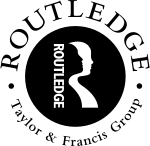Routledge facts for kids
 |
|
| Parent company | Taylor & Francis |
|---|---|
| Status | Active |
| Founded | 1851 |
| Founder | George Routledge |
| Country of origin | England |
| Headquarters location | Milton Park, Abingdon-on-Thames, Oxfordshire, England, UK |
| Distribution | World wide |
| Key people | Jeremy North (MD Books) |
| Publication types | Books and academic journals |
| Nonfiction topics | Humanities, social science, behavioral science, education, law |
Routledge is a publishing company from England. It was started in 1836 by George Routledge. The company creates books, magazines, and online materials for students and researchers. They focus on subjects like history, psychology, education, law, and social studies.
Each year, Routledge publishes about 1,800 academic magazines and 5,000 new books. They have a huge collection of over 140,000 titles. Routledge is known as one of the biggest academic publishers in the world for humanities and social sciences.
In 1998, Routledge joined the Taylor & Francis Group. This group used to be a competitor. Later, in 2004, Taylor & Francis merged with another company called Informa. Now, Routledge is a main part of Informa's academic publishing division. Routledge's main office is in Milton Park, England. They also have offices around the world, including in Philadelphia, Melbourne, New Delhi, Singapore, and Beijing.
Contents
The Story of Routledge
How Routledge Began
The company started in 1836. A bookseller named George Routledge published a travel guide. It was not very successful. In 1848, George and his brother-in-law, W. H. Warne, found a new idea. They started selling cheap copies of popular stories. These were for people traveling by train. This collection became known as the "Railway Library."
Growing with the Railways
The "Railway Library" became very popular as more people used trains. Because of this success, George Routledge and W. H. Warne's brother, Frederick Warne, started a new company. They called it George Routledge & Co. in 1851.
In 1852, the company got a big boost. They sold many copies of the book Uncle Tom's Cabin. This book was free to print in the UK. This success allowed them to pay author Edward Bulwer-Lytton a large sum of money. They gained the right to print all 35 of his works for 10 years. These books were sold cheaply in their "Railway Library" series.
Changes in Leadership
In 1858, George Routledge's son, Robert Warne Routledge, joined the company. The name changed to Routledge, Warne & Routledge. Frederick Warne left the company in 1859 after his brother W. H. Warne passed away. Frederick then started his own company, Frederick Warne & Co., in 1865. This company became famous for the Beatrix Potter books. In 1865, George Routledge's other son, Edmund Routledge, also became a partner. The company then became George Routledge & Sons.
Overcoming Challenges and Mergers
By 1899, the company faced financial difficulties. But they managed to recover after a big reorganization in 1902. Important people like Sir William Crookes and William Swan Sonnenschein helped them. After this, Routledge started buying and merging with other publishing companies. One of these was J. C. Nimmo Ltd. in 1903. In 1912, they took over the management of Kegan Paul, Trench, Trübner & Co..
These new companies brought many important academic books. From 1912 onwards, Routledge focused more on publishing scholarly works. They used the name "Kegan Paul Trench Trubner" for these books. In 1947, George Routledge and Sons officially merged with Kegan Paul Trench Trubner. The new company was called Routledge & Kegan Paul. They became well-known for books on philosophy, psychology, and social sciences.
Joining Larger Groups
In 1985, Routledge & Kegan Paul joined Associated Book Publishers (ABP). Then, in 1987, ABP was bought by International Thomson. Routledge kept its name and operations. It also added books from other publishers like Methuen and Tavistock Publications. In 1996, Routledge became an independent company again. This happened through a "management buyout" supported by a European investment firm called Cinven.
In 1997, Cinven bought two more publishers, Carfax and Spon. Then, in 1998, Cinven and Routledge's leaders agreed to a deal. Routledge was bought by the Taylor & Francis Group (T&F). Routledge continued to be a well-known name and part of T&F.
In 2004, T&F merged with Informa plc. Routledge is still a main publishing unit within Informa's academic publishing division. It publishes academic books, journals, and digital products in humanities and social sciences. Routledge has grown a lot by adding new titles and acquiring other publishing companies. When T&F buys books from other publishers, they often rebrand them under the Routledge name.
Routledge also cares about the environment. They are part of the SDG Publishers Compact. This means they work to support the Sustainable Development Goals (SDGs). For example, their print books and journals are certified as CarbonNeutral. This helps reduce their impact on the planet.
Key People at Routledge
Many talented people have worked at Routledge. Fredric Warburg, a famous English publisher, was an editor there in the early 1900s. Nina Stibbe, a novelist known for her book Love, Nina, also worked as an editor in the 1990s. William Germano, an editor in cultural studies, was a vice-president for twenty years. He later became a dean at Cooper Union.
Famous Authors Published by Routledge
Routledge has published works by many important thinkers. These include Adorno, Bohm, Butler, Derrida, Einstein, Foucault, Freud, Al Gore, Hayek, Jung, Levi-Strauss, McLuhan, Malinowski, Marcuse, Popper, Johan Rockström, Russell, Sartre, and Wittgenstein. Some of their works have been republished in special series like Routledge Classics.
See also
 In Spanish: Routledge para niños
In Spanish: Routledge para niños


